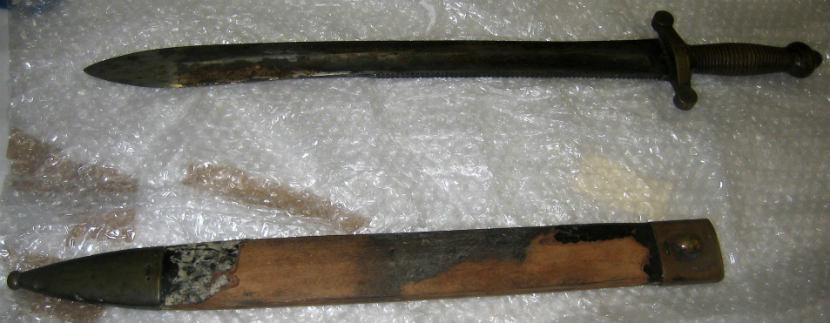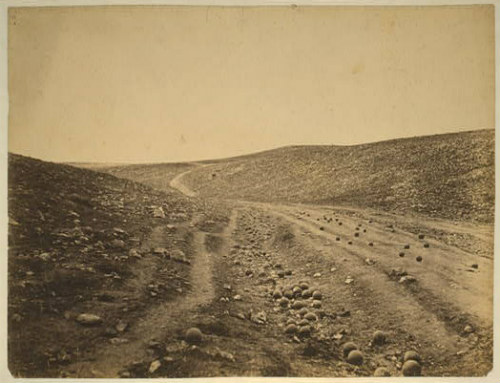The Fearful Object

A couple of years ago I attended a talk at a Museums Association conference entitled ‘The Fearful Object’. The idea behind which was a discussion of objects that are difficult for museums to display and interpret due to emotional or controversial associations. These can take many different forms, from artworks created by artists whose personal activities are unacceptable to us, to objects that are difficult in and of themselves, such as human remains, torture and force-feeding equipment, or weapons.
Just as there are some objects that we find ourselves drawn to, there are also those that repel us. Difficult or unpleasant objects; objects that can ignite a visceral response in us. I recently encountered one within the Maritime History collections that elicited such a response in myself.
I was in the stores to pack a sword from the Crimean War for transport to our conservation centre. I’d never seen the sword before, not even a picture, and I’m not sure quite what I expected but it wasn’t what I found. I suspect with the passion for fantasy that we currently have in modern pop culture many of us (possibly including me) hear the word sword and picture something elegant and ceremonial.
Well this sword was not some beautiful, gleaming Excalibur. It was a short, blunt, dull, mass-produced sword with a nasty looking serrated edge. I could not look at it and see anything but a brutal weapon designed for destruction. I found it repellent; fascinating but horrible. The moment I picked it up I wanted to put it down. It was that very response though that intrigued me and left me wanting to know more.
The Crimean war is probably best remembered by many now for the nursing contributions of Mary Seacole and Florence Nightingale and for, then poet laureate, Lord Alfred Tennyson’s The Charge of the Light Brigade. Despite taking place in 1854-56, in some ways it feels like the beginnings of modern warfare. For the first time the British public were receiving detailed reports in the press, sent back by war correspondent William Howard Russell of The Times. His depictions of the terrible conditions helped to inspire both Mary Seacole and Florence Nightingale and her team of nurses to travel to the squalid field hospitals. His articles are also said to have inspired Tennyson’s poem.

Library of Congress, Prints & Photographs Division LC-DIG-ppmsca-35546
In another striking piece of modernity, in Roger Fenton’s haunting work we see some of the very earliest war photography. These were converted to engravings and published in the Illustrated London News. For world famous Liverpool shipping line Cunard, Crimea was the start of modern warfare in another sense. For the first time Cunard’s merchant ships were requisitioned for war service, beginning their long association with the British armed forces. The shipping line have served in every major British conflict from Crimea up to and including the 1990 Gulf War. During the Crimean War Cunard ships transported more than 100,000 people, large quantities of stores and other war materials, served as troop transports, hospital ships and supply ships. It was Cunard’s Arabia which transported the horses that would form part of the Light Brigade charge immortalised by Tennyson.
These deliveries from Cunard and other merchant ships were vital during the terrible winter of 1854-55 when conditions for troops were worsened considerably by dreadful weather. Several British ships were wrecked during the winter storms and supplies became ever more scarce.
It is the role of these ships and of Cunard in particular that brings us back to our sword. George Paynter was a seafarer with Cunard for more than 45 years and made the journey to the Crimea on a number of occasions, on one of which he picked up our sword from a battlefield as a grim souvenir.
No matter how long I spend in this job the collections always maintain their ability to surprise, enchant, and appal me. I sometimes feel though that the objects that appal us, the ‘fearful’ ones, are often the most important ones. They are the ones that offer us a chance for discourse on a difficult topic.
I was lucky enough to hear the brilliant David Olusoga speaking the other week at Bangor University’s excellent History Festival and something he said particularly resonated with me.
We’ve come to see history as a place we go for comfort.
Much of history is not comfortable, it cannot and should not be so. If we cannot find a way to talk about the difficult and darker elements of our own history then we lose the opportunity to learn from them. In not learning from them I would argue we become complicit in their grimmer legacies of violence, prejudice and inequality.
The 63rd Manchesters were stationed in Ireland when the regiment received orders to the Crimea in 1854. In order to bring the regiment up to war strength they had to quickly seek out more men from the local population. Upon sailing more than two thirds of the private soldiers were untrained Irish recruits. By the end of the war two years later only 8 officers and 45 rank and file soldiers were left, the vast majority of the original 918 men from 1854 had been killed or invalided back to the UK.
It is more than 150 years since this sword saw service in the Crimean War, but there are plenty of other weapons being wielded in numerous conflicts around the globe. Young people still find themselves on the frontlines of wars they did not start.
On Remembrance Day it is important to remember both those who have lost their lives in past conflicts but also that conflict and war are still a fact of life for many. Warfare has not been consigned to history and reminders of human brutality should make us uncomfortable, but it is important that we don’t use that discomfort as a reason to turn away. The ‘fearful object’ often repels us with good cause, but if we can negotiate the difficult nature of such objects they often have much to teach us.
